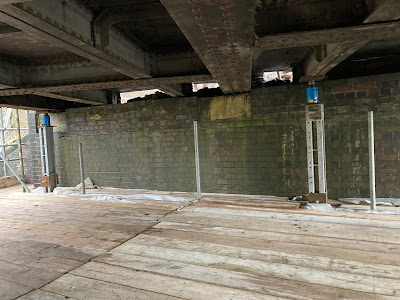BRIDGE 32 – REPAIR CONTRACT – JAN 2023 – first 3 weeks to 20.01.23.
Back in June 22, preparation of a scheme to carry out repairs and painting of Bridges 28 & 32 was started using the data from our Detailed Examination reports to create a comprehensive
schedule of works required. Both bridges had similar issues – mainly, leaking decks, collapsed end of deck ballast walls, minor steel repairs needed, and were geographically quite close, so it was decided to do both.
Neither had been painted since the GWSR acquired them over 40 years ago, so blast cleaning and painting was also to be done.
 |
Up side view of rusty parapet.
|
The work would require the road between Gretton and Gotherington to be completely closed and so an application (min 12 weeks’ notice required) was made to Glos. C.C. by our Traffic Management
company. GCC granted it without any issues. Unfortunately, being a country area, only a relatively long diversion route was available. Liaison with the two local schools and businesses on the route was also established. It
later came out that GCC were planning to arrange their own road closure to enable them to carry out a road improvement and lining operation during part of our closure, but we beat them to it!!. After some negotiations we have
managed to agree plans that both contractors are happy with, which will save another closure, at a later date!!
Volunteer Bridge design Engineer, John Sreeves was busy preparing the Construction drawings, specification and tender documents. Tenders were sought on 3rd September but the programmes that came back showed that it would be extremely tight to do both bridges between 3rd Jan. and 28th Feb. Consequently the tenders had to be revised to omit Bridge 28.
The GWR Trust then agreed to fund it (partly with money from the estate of former volunteer Civil Engineer – Peter Muir). Finally an order for Bridge 32 work was placed with contractors,
Walsh’s, on 14th November 22.
Work started site on Tuesday 3rd of January 23, with the installation of the contractor's welfare unit in the road below.
.jpg) |
Contractor's cabin in the road.
|
and the arrival of items of plant and machinery.
 |
Contractor's machinery.
|
On Wednesday 4th Jan. GWSR P-way then lifted the track and sleepers.
.jpg) |
Track being lifted by the PWay volunteers.
|
.jpg) |
Track removed (3 panels).
|
You can see some steel brackets sticking up from the deck plate.
 |
Deck plate with former brackets.
|
These were to fix large (approx. 19” x 6”) hardwood timber way-beams to the deck. These carried the rails, and there was no ballast or sleepers. In March 1928, the
timbers were removed, and ballast and sleepers were added. This added about 35T of ballast (340mm thick below the sleepers) to this small bridge, which has caused spillage problems, ever since!!
A very important part of the work would be the removal and eventual replacement of 6 of the 14 large stone pads which carried the main bridge steelwork. Obviously, the steelwork needed propping,
 |
Up side view showing props.
|
and a scaffold deck was also needed for the works.
 |
Up side view showing scaffolding and encapsulation.
|
The paint to be used is a high quality 3-coat resin-based product (used on oil rigs, etc) and this requires shot blasting to give the necessary surface preparation required. This should give
a min. 25 years life before any maintenance is required. The blast cleaning operation requires the entire steelwork to be encapsulated to stop the spread of blast emissions.
 |
Encapsulation of the works area.
|
The steelwork sub-contractor started on Monday 16th Jan. removing the brackets from the deck, and was arranging for a couple of small areas where there are holes through the ends of the deck, to have plates welding in.
 |
Deck plate holes revealed.
|
Investigation into the state of the end of deck ballast walls (One had virtually collapsed and the other 3 were cracked) was in hand..
.jpg) |
End of deck ballast walls. with angles.
|
Parts of these were also broken out to expose the ends of the steelwork where repairs were needed. In parallel, below the deck breaking out of the cracked and defective stone
bearing blocks was taking place.
 |
Deck plate holes and bottom flange plate missing.
|
 |
Props installed.
|
After two days of delay due to the very cold weather the shot blaster started work on Wednesday and had already blast cleaned and primed the main central girder, by yesterday.
 |
Centre girder blast cleaned and primed.
|
Meanwhile, on the upside, low mileage side, the drainage outlet pipe from the planned end of deck drains, has been installed, together with a set of steps to make track access safer in future.
 |
Drain outlet and steps.
|
Finally work has started to rebuild the top section of the brick wall which retains the road on the Upside, low mileage side.
 |
Retaining wall and standing water.
|
Work is also planned to investigate why standing water in the ditch from Culvert 31 B, which passes around the abutment, cannot get away.

This causes the ditch to silt up and, in turn the inside of the 3Ft. x 3 Ft. brick culvert.
.jpg) |
Interior of culvert.
|
 |
Detail of internal view of culvert.
|
Thanks to Ian Scholey and Jonathan Taylor (Lineside drainage) for the photographs.
Report by John Balderstone
Structures Engineer GWSR (20.01.2023)
































.jpg)

.jpg)
.jpg)





.jpg)






.jpg)
